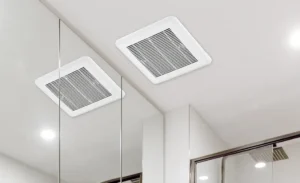Tired of musty odors and mold creeping into your home?
Ignoring poor ventilation doesn’t just cause discomfort—it risks your health and damages your living spaces.
Exhaust fans work by using a motor-driven fan blade or blower wheel to suck out stale, humid air from a room, pushing it through ducts to the outside.
Fresh air then replaces it, improving air quality and reducing humidity, odors, and pollutants.
Understanding exactly how exhaust fans operate is vital.
Keep reading to learn the details that can help you choose, install, and use your exhaust fan properly.
What Are the Main Components of an Exhaust Fan?
Wondering why your exhaust fan isn’t clearing odors or moisture effectively?
Without knowing the key components, you might never spot the real issue.
The main components of an exhaust fan include the motor, fan blades or blower wheel, duct collar, backdraft damper, housing, and grill.
The motor powers the blades, creating airflow that expels stale air outside through connected ductwork.

To fully understand how an exhaust fan works, let’s break down each part clearly:
Motor
The motor is the engine of your exhaust fan.
It uses electricity to turn the fan blades or blower wheel.
Lower-cost fans have simple fan blades, while more expensive models use blower wheels (also called squirrel cages).
Blower wheels usually move more air and make less noise.
| Fan Type | Airflow Efficiency | Noise Level |
|---|---|---|
| Fan Blade | Moderate | Louder |
| Blower Wheel | High | Quieter |
Fan Blades or Blower Wheel
These spin rapidly when powered by the motor.
Their spinning action creates suction, pulling air into the fan and forcing it through the ducting system.
Duct Collar
The duct collar connects the fan to the ductwork, guiding air safely outside.
Ducting sizes range from 3 to 6 inches.
Correct matching of duct size and fan is crucial.
Wrong duct sizing reduces airflow and increases noise.
| Duct Size | Typical Application |
|---|---|
| 3-4 inch | Small bathrooms |
| 6 inch | Large bathrooms, kitchens |
Backdraft Damper
This flap closes automatically when the fan stops running, preventing outside air from blowing back into the room.
There are two types:
- Gravity dampers: close naturally by weight.
- Spring-loaded dampers: use springs to close tightly.
Housing
This holds everything together and is installed into the ceiling or wall.
Installation methods include brackets, hanger bars, or tabs connected to ceiling joists.
Grill
This is the visible part of the exhaust fan.
The grill hides internal parts, protects the blades, and provides an attractive finish.
It also ensures proper airflow without restrictions.
Knowing these components makes maintaining, repairing, or replacing your exhaust fan easier and clearer.
What Are the Benefits of Exhaust Fans?
Not sure if you really need an exhaust fan?
Without one, you’re risking your home’s structure and your family’s health.
Exhaust fans remove moisture, odors, and airborne contaminants, improving indoor air quality.
They prevent mold growth, protect your home’s materials, and create healthier, more comfortable living environments.

Let’s dive deeper into why these benefits matter.
Reducing Moisture
Bathrooms, kitchens, and laundry rooms create lots of moisture.
Without proper ventilation, humidity builds up and causes serious problems:
- Mold and mildew growth
- Peeling paint or wallpaper
- Warping or rotting wood
- Rust on metal fixtures
Using an exhaust fan regularly removes damp air and protects your home’s structure.
Improving Air Quality
Exhaust fans pull out stale, polluted air filled with odors and contaminants.
These include cooking smells, smoke, chemical fumes, and bacteria.
By moving polluted air outside, fresh air comes in, improving overall health and comfort.
| Pollutants Removed | Health Risks Prevented |
|---|---|
| Mold & mildew | Allergies, respiratory issues |
| Chemical odors | Headaches, nausea |
| Smoke particles | Lung irritation, discomfort |
Comfort & Temperature Regulation
Exhaust fans also help maintain comfortable temperatures.
By removing hot air, they allow cooler air from outdoors to enter.
This helps control indoor temperature and reduce the use of air conditioners, saving energy and money.
Properly using exhaust fans directly contributes to a safer, more comfortable, and cost-efficient home environment.
What Types of Exhaust Fans Are Available?
Confused by all the different exhaust fan options?
Choosing the wrong type could mean poor performance and wasted money.
The main types of exhaust fans are ceiling-mounted, inline, wall-mounted, and combination units.
Each type suits different spaces, installation methods, noise levels, and ventilation needs.

Let’s clearly explore each exhaust fan type:
Ceiling-Mounted Fans
Ceiling-mounted fans are common in bathrooms and kitchens.
Installed directly into the ceiling, these fans effectively remove moisture and odors.
They work by sucking air upward, pushing it through ducts to the outside.
These fans often include lights, heaters, or decorative finishes.
Inline Fans
Inline fans are installed remotely, usually in attic spaces.
They’re connected to one or multiple ceiling vents through ducts.
Benefits include quieter operation, powerful airflow, and the ability to ventilate multiple locations using just one fan.
| Type | Noise Level | Best Application |
|---|---|---|
| Ceiling-mounted | Moderate | Bathrooms, kitchens |
| Inline | Quietest | Large rooms, multiple points |
Wall-Mounted Fans
Wall-mounted fans are suitable for rooms without attic access or high ceilings.
Installed directly into walls, these fans quickly move air outside.
They’re effective without extensive ductwork, especially on exterior walls.
Combination Units
These exhaust fans offer multiple functions in one unit:
- Lighting
- Heating
- Humidity sensors
- Motion sensors
While pricier, combination units add convenience and efficiency, especially in bathrooms or laundry rooms.
Choosing the right type depends on your home’s layout, your ventilation needs, and budget considerations.
How to Properly Install an Exhaust Fan?
Struggling with moisture or odors even after installing an exhaust fan?
Improper installation may be the issue.
Proper installation involves correctly matching fan size and ducting, minimizing ductwork length, venting directly outside, and proper electrical wiring.
This ensures maximum airflow efficiency, performance, and safety.

Let’s break down installation clearly:
Selecting Fan Size (CFM)
Match the fan’s CFM (cubic feet per minute) rating with room size:
| Room Size (sq. ft.) | Recommended CFM |
|---|---|
| 50 | 50 CFM |
| 50-100 | 100 CFM |
| 100-150 | 150 CFM |
| Over 150 | 200+ CFM |
Ductwork Installation
Ductwork must vent directly outside—not into attics or crawl spaces.
Shorter, straight duct runs with minimal bends ensure better airflow.
Incorrect ducting leads to poor ventilation, noise, and possible moisture damage.
Electrical Wiring
Wire the fan independently from lighting if possible.
Running the fan for 20-30 minutes after showers or cooking ensures proper moisture removal without wasting electricity.
Careful, correct installation ensures your fan works effectively, protecting your home’s air quality.
Conclusion
Understanding how exhaust fans work helps you maintain healthier indoor air, prevent structural damage, and increase comfort—making your home safe and enjoyable to live in.
FAQ
Can exhaust fans be used in kitchens to remove cooking odors and smoke?
Yes, exhaust fans are commonly used in kitchens to eliminate cooking odors, smoke, and airborne grease, thereby improving air quality and reducing the buildup of contaminants on surfaces.
Do exhaust fans consume a lot of electricity?
Exhaust fans are generally energy-efficient appliances. The exact energy consumption depends on the fan’s size, motor power, and usage duration.
Can I install an exhaust fan myself, or should I hire a professional?
While some exhaust fans can be installed by individuals with basic DIY skills, hiring a professional ensures proper installation, especially for units requiring new ductwork or electrical connections.
How do I maintain my exhaust fan to ensure it functions properly?
Regular maintenance includes cleaning the fan blades, grills, and filters to prevent dust and grease buildup. Ensure that the ductwork is clear of obstructions to maintain optimal airflow.
Can exhaust fans help reduce indoor allergens?
Yes, by expelling airborne particles such as dust, pollen, and pet dander, exhaust fans can help reduce indoor allergens, contributing to better respiratory health.
Are there exhaust fans with additional features like lighting or heating?
Yes, many modern exhaust fans come with integrated features such as lighting, heating elements, humidity sensors, and motion detectors for enhanced functionality and convenience.
What is the lifespan of a typical exhaust fan?
The lifespan of an exhaust fan varies based on usage and maintenance but typically ranges from 10 to 15 years. Regular cleaning and timely repairs can extend its operational life.
Can exhaust fans be used in other areas besides bathrooms and kitchens?
Yes, exhaust fans can be installed in laundry rooms, basements, garages, or any area where moisture, odors, or airborne contaminants are a concern.
How do I choose the right size exhaust fan for my room?
To select the appropriate size, calculate the room’s volume (length × width × height) and choose a fan that can exchange the air 8 to 10 times per hour.
Are there any safety concerns associated with exhaust fans?
Ensure that exhaust fans are properly installed and vented to the outdoors to prevent moisture buildup and potential mold growth. Regular maintenance is essential to prevent fire hazards from lint or grease accumulation.


